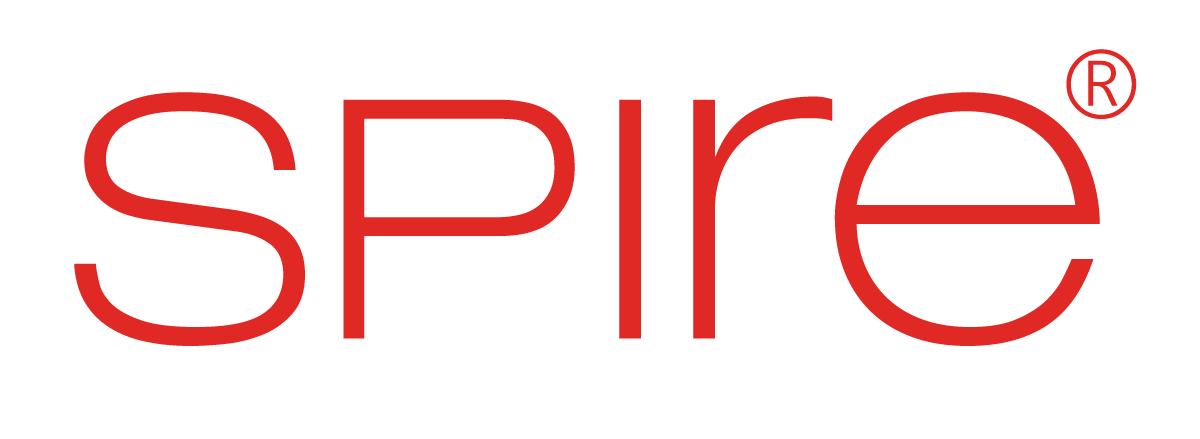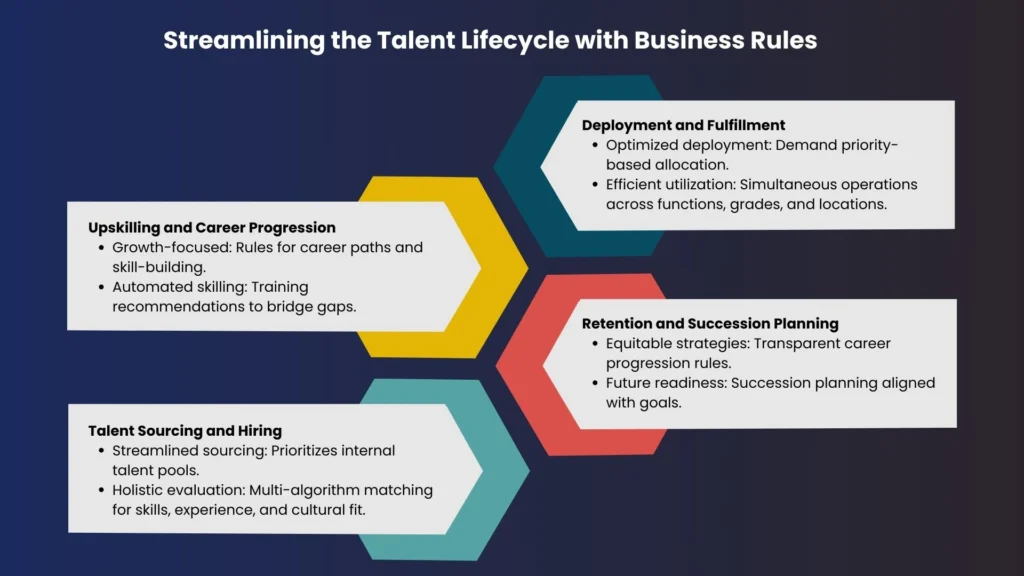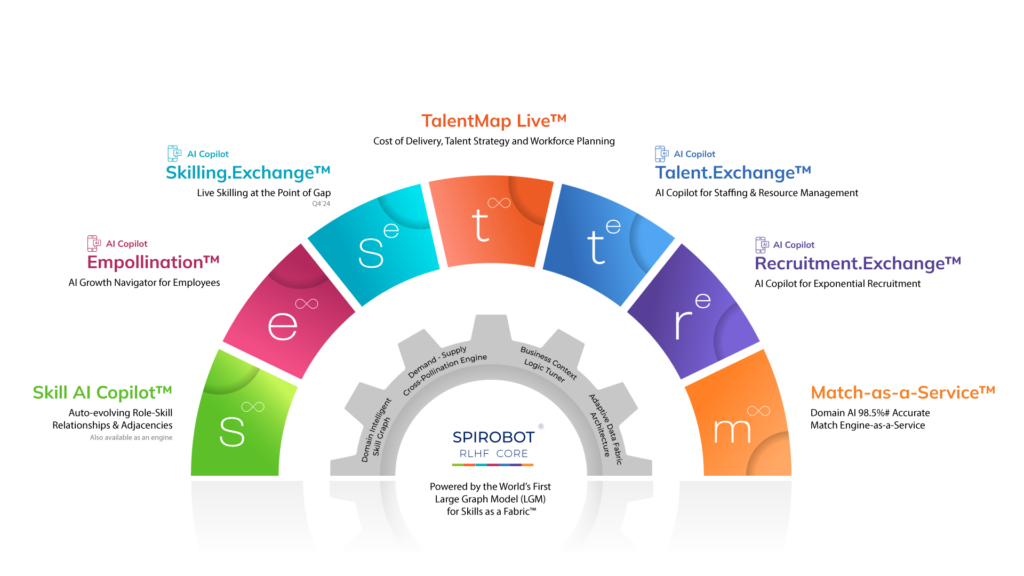In the rapidly evolving talent landscape, organizations face increasing pressure to efficiently manage the entire talent lifecycle, from acquisition to deployment, development, and retention. Business rules in talent management have emerged as a game-changer, enabling scalable systems that adapt to the complexities of diverse industries, functions, and locations. These rules, powered by advanced technologies such as Domain-Intelligent AI, streamline talent operations and unlock significant efficiency gains.
By defining clear parameters for decision-making, business rules create a structured approach to managing talent across the lifecycle. In this blog, we’ll explore business rules’ pivotal role in talent lifecycle management, how they are implemented, and their transformative impact on talent operations. Finally, we’ll discuss how Spire.AI is helping organizations leverage business context logic and rules to optimize their talent systems.
What Are Business Rules in Talent Management?
Business rules in talent management refer to the predefined policies, processes, and algorithms that govern decision-making throughout the talent lifecycle. These rules align talent operations with organizational goals, ensuring consistent and data-driven decisions across hiring, deployment, upskilling, and retention activities. Examples include prioritizing internal talent deployment over external hiring, aligning promotions with tenure or performance metrics, and optimizing resource allocation based on project margins or criticality.
By integrating these rules into talent systems, organizations can:
- Ensure fairness and transparency in decision-making.
- Streamline operations to reduce manual intervention.
- Adapt quickly to changing business needs.
Making Talent Operations More Contextual with Business Rules
Business rules in talent operations provide the foundation for scaling talent systems effectively. They enable organizations to manage complex, multi-layered decisions involving employees, roles, and business goals.
- Optimizing Deployment with Prioritization Rules
Deployment rules ensure that employees are allocated based on critical parameters like project urgency, skill relevance, and cost efficiency. For example: - High-margin projects are prioritized over low-margin ones.
- Resources are allocated first to internal roles before external hiring is considered.
- Enhancing Visibility with Real-Time Skill Inventories
Business rules powered by Domain-Intelligent AI create dynamic skill inventories. This enables organizations to maintain up-to-date records of employee skills, ensuring that talent is deployed effectively where it’s most needed. - Supporting Continuous Development
Rules that identify skill gaps at the point of need can direct employees to relevant training resources, certifications, or mentorship opportunities. This targeted approach reduces generic learning and development initiatives. - Aligning Talent Operations with Business Context
Business context logic ensures that rules are applied flexibly across various business units, functions, and geographies. For example, deploying resources in high-demand locations or scaling operations based on customer requirements.
Integrating Business Rules Across the Talent Lifecycle
The talent lifecycle spans multiple stages, from sourcing and hiring to retention and upskilling. Business rules are a unifying framework that ensures seamless transitions across these stages.
1. Talent Sourcing and Hiring
Business rules streamline sourcing by prioritizing internal talent pools and aligning recruitment efforts with organizational needs. Multi-algorithm matching ensures that candidates are evaluated holistically, considering skills, past experiences, and cultural fit.
2. Deployment and Fulfillment
Rules like demand priority-based allocation ensure optimal deployment. Simultaneous operations across multiple business contexts—such as functions, grades, or locations—enable efficient resource utilization, as illustrated by Spire.AI’s Business Context Logic.
3. Upskilling and Career Progression
Organizations can foster employee growth by implementing career path rules and skilling recommendations while addressing evolving business demands. Automated recommendations for training and certifications empower employees to bridge skill gaps.
4. Retention and Succession Planning
Retention strategies often revolve around rules that promote transparency in career progression and equitable performance evaluations. These rules also ensure that succession planning is aligned with long-term organizational goals.
Spire.AI: Enhancing Talent Operations with Business Context Logic and Domain-Intelligent AI
Spire.AI is revolutionizing talent management by combining Domain-Intelligent AI with Business Context Logic (BCL)—a sophisticated layer of configurable algorithms and business rules tailored to an organization’s needs. This integration ensures talent systems go beyond mere automation to deliver precise, context-aware solutions that adapt dynamically to operational complexities and organizational priorities.
What Is Business Context Logic (BCL)?
At its core, the Business Context Logic is a decision-making framework that enables organizations to apply multiple simultaneous algorithms across diverse contexts, such as business types, geographic locations, employee grades, and service lines. Unlike static systems, BCL is designed to adapt and function dynamically, aligning with the unique needs of various business units, projects, and strategic goals.
The Business Context Logic is a decision-making framework that enables organizations to apply multiple simultaneous algorithms across diverse contexts, such as business types, geographic locations, employee grades, and service lines.
For instance:
- Parallel Logic Operations: BCL algorithms can simultaneously address the demands of various business functions, ensuring that every unit operates with the logic most relevant to its needs.
- Precision and Adaptability: The configurable nature of BCL allows organizations to prioritize talent decisions based on financial goals, resource availability, project criticality, and customer requirements.
With BCL, Spire.AI empowers organizations to streamline talent lifecycle processes such as deployment, skill alignment, workforce planning, and reskilling, making talent systems more efficient and context-specific.
How Business Context Logic Powers Talent Operations
The Spire.AI unique implementation of Business Context Logic incorporates a multi-faceted approach to ensure that talent decisions are precise, efficient, and aligned with business priorities. Key components include:
1. Project Health Parameters
BCL integrates critical project-related parameters to ensure that resources are allocated to maximize business value. Examples include:
- Account Status: Determines whether the account is retained, acquired, or developed, prioritizing high-value or strategic accounts.
- Project Margins and Deal Size: Focuses on deploying talent to high-margin and large-scale projects for better ROI.
- Commercial and Delivery Models: Aligns resources based on whether the project follows a BFD (Build-from-Demand) or BTM (Build-to-Market) model, as well as delivery types like managed services or staff augmentation.
- Skill Cluster Pricing: Matches employee skills to pricing structures, ensuring cost-efficiency in deployments.
These parameters enable organizations to allocate resources intelligently, ensuring that high-priority and high-margin projects receive the attention they deserve.
2. Anti-Starvation Rules
One of the critical challenges in talent systems is balancing supply and demand across multiple functions, geographies, and units. Spire.AI’s Anti-Starvation Rules ensure:
- Maximum Demand Coverage: Talent is allocated to ensure that high-priority demands are met without resource bottlenecks.
- Maximum Supply Utilization: Resources are efficiently utilized, preventing under-deployment of employees and ensuring they are consistently engaged in meaningful roles.
Spire.AI ensures smoother operations across the organization by preventing resource starvation, with no business unit left without critical resources.
3. Deployment Priority and Pyramidization
Deployment rules and pyramidization strategies further enhance talent utilization by:
- Prioritizing High-Criticality Demands: Resources are allocated first to projects with higher criticality levels, such as P1 or P2 demands.
- Pyramidization: Maintains a balanced workforce structure by aligning deployment strategies with grade levels, tenure, and performance metrics. For instance, grade-based preferences (Grade -1 or -2) ensure optimal junior and senior talent utilization.
- Internal First Strategies: Prioritizes internal talent deployment before triggering external hiring, reducing costs and increasing employee engagement.
These strategies ensure that talent decisions are cost-effective and aligned with long-term organizational goals.
Spire.AI in Action: How BCL Transforms Talent Management
Spire.AI talent systems, powered by BCL and Domain-Intelligent AI, have delivered transformative results for organizations. Here’s a step-by-step look at how the system operates in real-world scenarios:
- Demand Analysis and Prioritization:
- All demands are ranked based on urgency, criticality (P1–P3 levels), and business impact.
- Algorithms evaluate potential matches based on quality thresholds, ensuring that the best resources are deployed to high-priority demands.
- Talent Matching and Deployment:
- Employees are matched to demands using multi-algorithm logic, considering factors such as skill relevance, project health, and financial constraints.
- Anti-starvation rules ensure resources are evenly distributed, avoiding overloading or underutilizing specific units.
- Continuous Optimization:
- The system monitors performance metrics such as resource utilization, skill alignment, and financial outcomes to refine allocations in real-time.
- Pyramidization strategies are applied to maintain a balanced workforce structure.
- Internal Talent Reskilling and Utilization:
- Internal candidates are prioritized for open roles, with targeted reskilling programs triggered automatically for roles requiring additional expertise.
Final Thoughts
Modern talent operations require systems that are adaptive, precise, and aligned with business goals. Organizations can move beyond basic automation by combining Business Rules and Domain-Intelligent AI to create dynamic, scalable systems. This approach ensures efficient resource allocation, real-time adaptability, and maximum alignment with strategic priorities.
Spire.AI solutions exemplify this by enabling simultaneous, context-specific algorithms, maximizing internal talent utilization, and optimizing demand fulfillment. With tools like anti-starvation rules and skill-based allocation, talent operations become more impactful and cost-efficient.
In a rapidly changing world, precision-driven talent operations are no longer optional—they are essential for success. Organizations that adopt this approach will transform their workforce into a strategic advantage, ready to meet future challenges.







